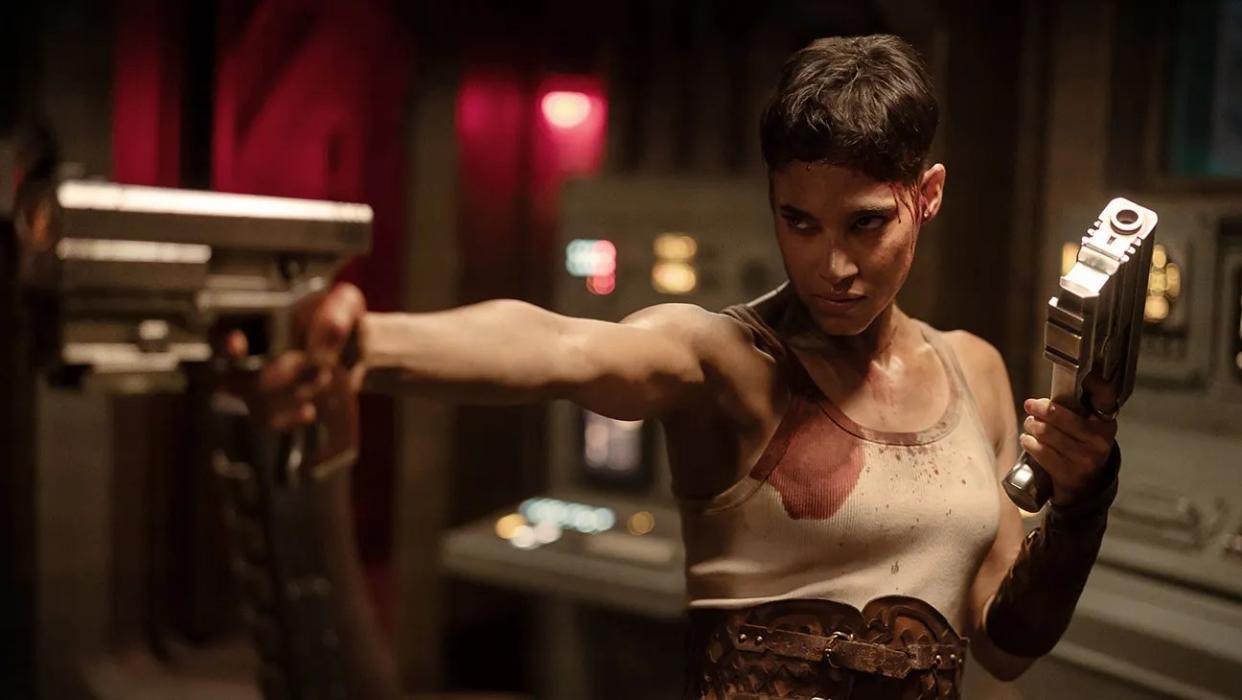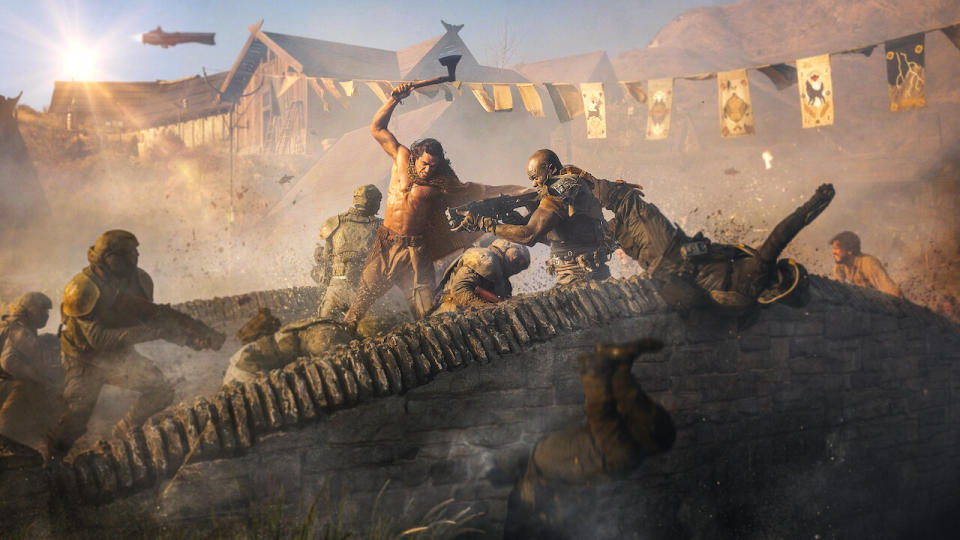‘Rebel Moon — Part Two: The Scargiver’ Review: The Second Half of Zack Snyder’s Sci-Fi Debacle Is Almost as Disastrous as the First

“Rebel Moon — Part Two: The Scargiver” has been dead since last December, when the irredeemable first chapter of Zack Snyder’s hyper-derivative space opera was released “in theaters” and on Netflix to deafening silence. As I concluded my review at the time: “It’s hard to be even morbidly curious, let alone excited, about any future iterations or installments of a franchise so determined to remix a million things you’ve seen before into one thing you’ll wish you’d never seen at all.”
And so, much as I might have hoped that the second and more concentrated half of Snyder’s sci-fi “Seven Samurai” would somehow atone for the sins of its previous chapter, I wasn’t exactly shocked to discover that it lacks any trace of a pulse from the moment it starts. Five months in the morgue can have that effect. Be that as it may, the sheer lifelessness of this Sora-like spectacle still manages to defy even the lowest of expectations.
More from IndieWire
If “The Scargiver” is shorter, more straightforward, and generally less of a headache than “Part One: A Child of Fire,” its failures are twice as baffling. This was supposed to be the easy part.
The “Rebel Moon” project was conceived as a “Star Wars” spinoff, and I don’t envy the challenge that Snyder faced to create a cinematic universe of his own, especially because the “Dawn of the Dead” and “300” filmmaker has always been a cover artist disguised as a visionary auteur.
“A Child of Fire” was burdened with introducing the remote farm world of Veldt, whose grain is — hilariously — still as invaluable to the space-age fascists of the Motherworld as it was to the 16th century bandits who harassed the hungry villagers in Kurosawa’s original. It was tasked with establishing the militaristic Imperium as the Motherworld’s war machine, Ed Skrein’s Noble as its most sadistic enforcer, and Sofia Boutella’s Kora as a Veldt citizen with secret ties to Noble’s boss, an evil regent who slaughtered the Motherworld’s royal family and seized control over the galaxy by force. The film had to articulate why Noble’s dreadnought would threaten such an unassuming moon, and then visualize a solar system’s worth of planets as Kora and her farmer crush Gunnar (Michiel Huisman) traveled from one soulless CGI landscape to the next in search of mercenaries who might be convinced to help defend Veldt from the Imperium’s forthcoming assault despite the slimmest possible hope for survival.
“A Child of Fire” ended with Kora, Gunnar, and the motley crew of interstellar soldiers they’d managed to assemble returning to Veldt in order to prepare for the fight to come. The stage was set for a feature-length battle sequence that would allow Snyder to focus on his strengths, such as they are, and deliver his fans an undiluted mega-dose of fetishistically speed-ramped sci-fi combat without too much plot, character detail, world-building, or any other kind of pesky narrative bullshit getting in the way.
And don’t get me wrong: If you want to watch space Nazis fire red laser beams at vaguely Scandinavian farm people during an interminable siege that’s staged with exactly none of the panache and enthusiasm that made even the worst of Snyder’s pre-streaming work feel distinct, you’ve come to the right place. This is the “Citizen Kane” of whatever that is. But first, you’ll have to sit through — or scrub past — a full hour of watching Djimon Hounsou, Bae Doona, and the rest of the film’s ensemble cast harvest wheat in slow-motion as the singers on Tom Holkenborg’s appropriately self-serious choral score wail over the soundtrack.
Seriously, it would be almost impossible for me to overstate how much of this movie is just shots of sweaty people swinging their scythes at the two massive grain fields that Snyder’s team planted for the production. I’d hoped that “The Scargiver” would pay off some of the story beats that were so agonizingly seeded in “A Child of Fire,” but I didn’t expect that Snyder would take the “me sowing/me reaping” of it all quite this literally, or that both parts of the process would be equally unfun.
Surprising as it might be that this truncated, PG-13 version of Snyder’s eventual director’s cut still finds the time for long stretches of agriculture porn, I suppose that’s a byproduct of his inexplicable decision to squeeze every supporting character’s entire backstory into a single, dramatically moribund sequence in which they sit around a table and regale each other with identical stories about how the Imperium killed everyone they loved. It might be the only part of the movie in which Staz Nair’s Tarzan-sculpted Tarak says more than five words in a row, or that Elise Duffy’s Milius — who Wikipedia assures me was in the first one — is invited to grow into something more than a ChatGPT-promoted Furiosa clone… an invitation she rejects with extreme prejudice.
Even at the end of a combined running time that now stretches more than four hours long, the warriors in “Rebel Moon” continue to feel generated at random, which proves be the most fatal issue of many in a film that stakes its emotional core on the hope that Kora and her friends will become more than mere weapons.

It’s nice that Hounsou gets to sing a lovely battle hymn in a hybrid of two African languages, just don’t expect to learn anything you didn’t already know about the degenerate ex-general he was cast to play, or to see Titus’ unique skill set reflected in the choreography of the skirmish that dominates the second half of the film. At least Bae’s stunt training is rewarded with a solo fight in which her dual-wielding cyborg swordmaster gets to hack and slash her way through some faceless goons, but the choppy blocking is frequently interrupted by cut-aways to other parts of the battle. (The siege has no discernible trace of rhythm or flow, and the only logic it seems to follow is that highlighting a different element of the action every few seconds might stop Netflix subscribers from clicking over to “Bridgerton” instead.) And the outcome of the fight only serves to underline the lack of humanity that Snyder and his co-writers Shay Hatten and Kurt Johnstad were able find in their characters.
Perhaps it’s telling that the film’s most expressive action beat is reserved for a robot, but even that display — an homage of sorts to Yoda’s unexpected ambush at the end of “Attack of the Clones” — is too gagged by its own desperate bad-assery to deliver even a fraction of the fist-pumping fun that George Lucas was able to generate in 2002. George Lucas! In 2002!
At least Kora has a slightly better chance to shine than the rest of their counterparts; not on the battlefield, where she’s subject to the same bland series of sword fights and dirt explosions as everybody else, but at least in the backstory that led her there. The character’s tragic foundation is rooted in one of the single goofiest things I’ve ever seen on a movie screen (a string quartet with bags over their faces performs during a coup attempt, their live accompaniment growing more intense as the slaughter begins a few feet away), and it ends with Kora experiencing a change of heart so abrupt that she should probably see a cardiologist. Still, somewhere in between she’s forced to make a powerful decision that puts her at odds with her own violent potential.
There’s a potentially intriguing storm at work inside her soul, and a better film that didn’t waste Kora’s pathos and fury on Skrein’s one-note uber-villain might have done something with it. But this is not that film, Boutella is denied any chance to meaningfully process her character’s pain, and the unintentionally comedic bit where she laments the death of a comrade by seething “Why can’t I have this one thing?” doesn’t feel like a soldier’s anguished expression of unfathomable loss so much as it does a first-draft placeholder that Snyder and co. forgot to re-write.
Maybe Kora’s emotions will be more fleshed out in the director’s cut, or in any of the subsequent “Rebel Moon” movies that Snyder has recently threatened to make (in what a cynic might see as a deliberate attempt to distract people from the mind-numbing anticlimax of this one). In some respects “The Scargiver” feels even less salvageable than “A Child of Fire,” as no amount of additional, R-rated violence could redeem the unstructured banality of Snyder’s beige-bland action, but it’s possible that his characters might find another dimension — or a single dimension — from some of the interstitial dialogue scenes that may have been lost along the way.
Regardless, this franchise certainly has room to grow, as Noble is never framed as anything more than the first boss in Kora’s quest to confront her adoptive father. If this catastrophic bore of a film isn’t game over for “Rebel Moon,” then nothing will be able to stand in her way.
Grade: D
“Rebel Moon — Part Two: The Scargiver” is now available to stream on Netflix.
Best of IndieWire
Sign up for Indiewire's Newsletter. For the latest news, follow us on Facebook, Twitter, and Instagram.

 Yahoo News
Yahoo News 
